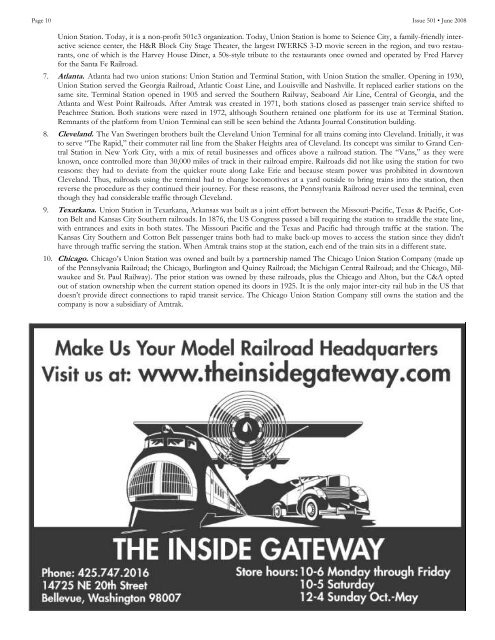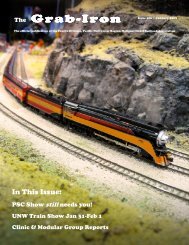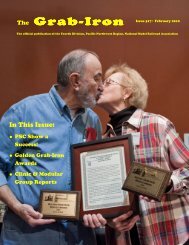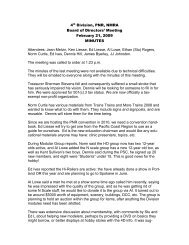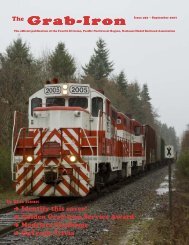June 2008 - the 4th Division ⢠PNR ⢠NMRA
June 2008 - the 4th Division ⢠PNR ⢠NMRA
June 2008 - the 4th Division ⢠PNR ⢠NMRA
Create successful ePaper yourself
Turn your PDF publications into a flip-book with our unique Google optimized e-Paper software.
Page 10 Issue 501 • <strong>June</strong> <strong>2008</strong><br />
Union Station. Today, it is a non-profit 501c3 organization. Today, Union Station is home to Science City, a family-friendly interactive<br />
science center, <strong>the</strong> H&R Block City Stage Theater, <strong>the</strong> largest IWERKS 3-D movie screen in <strong>the</strong> region, and two restaurants,<br />
one of which is <strong>the</strong> Harvey House Diner, a 50s-style tribute to <strong>the</strong> restaurants once owned and operated by Fred Harvey<br />
for <strong>the</strong> Santa Fe Railroad.<br />
7. Atlanta. Atlanta had two union stations: Union Station and Terminal Station, with Union Station <strong>the</strong> smaller. Opening in 1930,<br />
Union Station served <strong>the</strong> Georgia Railroad, Atlantic Coast Line, and Louisville and Nashville. It replaced earlier stations on <strong>the</strong><br />
same site. Terminal Station opened in 1905 and served <strong>the</strong> Sou<strong>the</strong>rn Railway, Seaboard Air Line, Central of Georgia, and <strong>the</strong><br />
Atlanta and West Point Railroads. After Amtrak was created in 1971, both stations closed as passenger train service shifted to<br />
Peachtree Station. Both stations were razed in 1972, although Sou<strong>the</strong>rn retained one platform for its use at Terminal Station.<br />
Remnants of <strong>the</strong> platform from Union Terminal can still be seen behind <strong>the</strong> Atlanta Journal Constitution building.<br />
8. Cleveland. The Van Sweringen bro<strong>the</strong>rs built <strong>the</strong> Cleveland Union Terminal for all trains coming into Cleveland. Initially, it was<br />
to serve “The Rapid,” <strong>the</strong>ir commuter rail line from <strong>the</strong> Shaker Heights area of Cleveland. Its concept was similar to Grand Central<br />
Station in New York City, with a mix of retail businesses and offices above a railroad station. The “Vans,” as <strong>the</strong>y were<br />
known, once controlled more than 30,000 miles of track in <strong>the</strong>ir railroad empire. Railroads did not like using <strong>the</strong> station for two<br />
reasons: <strong>the</strong>y had to deviate from <strong>the</strong> quicker route along Lake Erie and because steam power was prohibited in downtown<br />
Cleveland. Thus, railroads using <strong>the</strong> terminal had to change locomotives at a yard outside to bring trains into <strong>the</strong> station, <strong>the</strong>n<br />
reverse <strong>the</strong> procedure as <strong>the</strong>y continued <strong>the</strong>ir journey. For <strong>the</strong>se reasons, <strong>the</strong> Pennsylvania Railroad never used <strong>the</strong> terminal, even<br />
though <strong>the</strong>y had considerable traffic through Cleveland.<br />
9. Texarkana. Union Station in Texarkana, Arkansas was built as a joint effort between <strong>the</strong> Missouri-Pacific, Texas & Pacific, Cotton<br />
Belt and Kansas City Sou<strong>the</strong>rn railroads. In 1876, <strong>the</strong> US Congress passed a bill requiring <strong>the</strong> station to straddle <strong>the</strong> state line,<br />
with entrances and exits in both states. The Missouri Pacific and <strong>the</strong> Texas and Pacific had through traffic at <strong>the</strong> station. The<br />
Kansas City Sou<strong>the</strong>rn and Cotton Belt passenger trains both had to make back-up moves to access <strong>the</strong> station since <strong>the</strong>y didn't<br />
have through traffic serving <strong>the</strong> station. When Amtrak trains stop at <strong>the</strong> station, each end of <strong>the</strong> train sits in a different state.<br />
10. Chicago. Chicago’s Union Station was owned and built by a partnership named The Chicago Union Station Company (made up<br />
of <strong>the</strong> Pennsylvania Railroad; <strong>the</strong> Chicago, Burlington and Quincy Railroad; <strong>the</strong> Michigan Central Railroad; and <strong>the</strong> Chicago, Milwaukee<br />
and St. Paul Railway). The prior station was owned by <strong>the</strong>se railroads, plus <strong>the</strong> Chicago and Alton, but <strong>the</strong> C&A opted<br />
out of station ownership when <strong>the</strong> current station opened its doors in 1925. It is <strong>the</strong> only major inter-city rail hub in <strong>the</strong> US that<br />
doesn’t provide direct connections to rapid transit service. The Chicago Union Station Company still owns <strong>the</strong> station and <strong>the</strong><br />
company is now a subsidiary of Amtrak.


